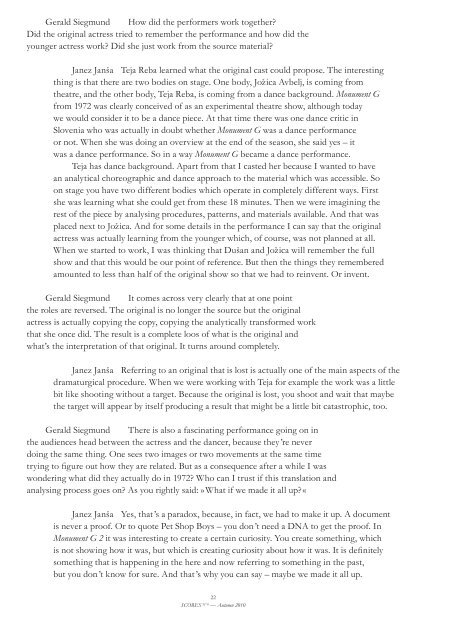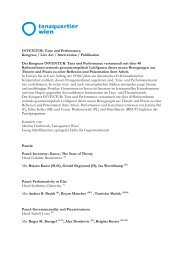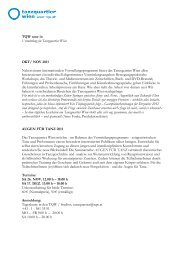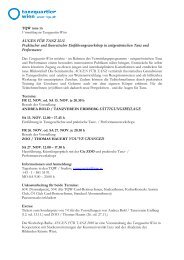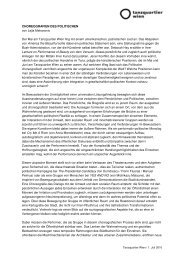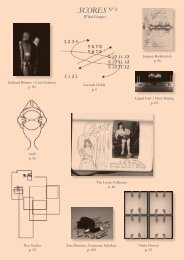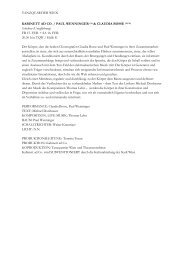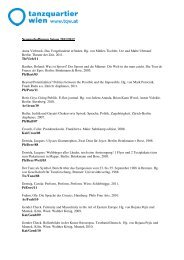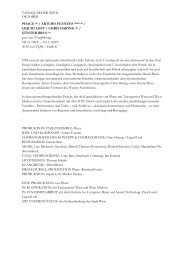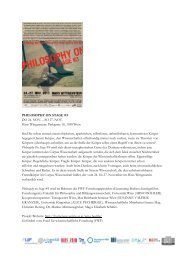SCORES NO 0 - Tanzquartier Wien
SCORES NO 0 - Tanzquartier Wien
SCORES NO 0 - Tanzquartier Wien
Create successful ePaper yourself
Turn your PDF publications into a flip-book with our unique Google optimized e-Paper software.
Gerald Siegmund how did the performers work together?<br />
Did the original actress tried to remember the performance and how did the<br />
younger actress work? Did she just work from the source material?<br />
Janez Janša Teja Reba learned what the original cast could propose. The interesting<br />
thing is that there are two bodies on stage. One body, Joˇzica Avbelj, is coming from<br />
theatre, and the other body, Teja Reba, is coming from a dance background. Monument G<br />
from 1972 was clearly conceived of as an experimental theatre show, although today<br />
we would consider it to be a dance piece. At that time there was one dance critic in<br />
Slovenia who was actually in doubt whether Monument G was a dance performance<br />
or not. When she was doing an overview at the end of the season, she said yes – it<br />
was a dance performance. So in a way Monument G became a dance performance.<br />
Teja has dance background. Apart from that I casted her because I wanted to have<br />
an analytical choreographic and dance approach to the material which was accessible. So<br />
on stage you have two different bodies which operate in completely different ways. First<br />
she was learning what she could get from these 18 minutes. Then we were imagining the<br />
rest of the piece by analysing procedures, patterns, and materials available. And that was<br />
placed next to Joˇzica. And for some details in the performance I can say that the original<br />
actress was actually learning from the younger which, of course, was not planned at all.<br />
When we started to work, I was thinking that Dušan and Joˇzica will remember the full<br />
show and that this would be our point of reference. But then the things they remembered<br />
amounted to less than half of the original show so that we had to reinvent. Or invent.<br />
Gerald Siegmund It comes across very clearly that at one point<br />
the roles are reversed. The original is no longer the source but the original<br />
actress is actually copying the copy, copying the analytically transformed work<br />
that she once did. The result is a complete loos of what is the original and<br />
what’s the interpretation of that original. It turns around completely.<br />
Janez Janša Referring to an original that is lost is actually one of the main aspects of the<br />
dramaturgical procedure. When we were working with Teja for example the work was a little<br />
bit like shooting without a target. Because the original is lost, you shoot and wait that maybe<br />
the target will appear by itself producing a result that might be a little bit catastrophic, too.<br />
Gerald Siegmund There is also a fascinating performance going on in<br />
the audiences head between the actress and the dancer, because they ’re never<br />
doing the same thing. One sees two images or two movements at the same time<br />
trying to figure out how they are related. But as a consequence after a while I was<br />
wondering what did they actually do in 1972? Who can I trust if this translation and<br />
analysing process goes on? As you rightly said: » What if we made it all up? «<br />
Janez Janša yes, that ’s a paradox, because, in fact, we had to make it up. A document<br />
is never a proof. Or to quote Pet Shop Boys – you don ’t need a DNA to get the proof. In<br />
Monument G 2 it was interesting to create a certain curiosity. you create something, which<br />
is not showing how it was, but which is creating curiosity about how it was. It is definitely<br />
something that is happening in the here and now referring to something in the past,<br />
but you don ’t know for sure. And that ’s why you can say – maybe we made it all up.<br />
22<br />
<strong>SCORES</strong> <strong>NO</strong> 0 — Autumn 2010<br />
Gerald Siegmund Picking up the idea presented in my introduction of why<br />
at the moment we are so fascinated by reconstructions of historical performances; I<br />
would like to ask both of you, Janez and Boris, why do an archaeological work?<br />
Janez Janša By just doing something which has already been done, the piece became<br />
something else. Seeing Boris’ piece made me realize that this is not a Cunningham-show.<br />
Cunningham is turned into something else. And Monument G 2 is not a Dušan Jovanovičshow,<br />
although he is one of the directors. We signed that work together. In Monument G 2<br />
we work very explicitly with the idea of doubling. Doubling is one of the key elements in<br />
performance. In the theatre you always double something. This is also very clear in your<br />
piece, Boris. you double an image and you double a choreographic procedure. And doubling<br />
on stage is underlined in Monument G 2: there are two shows going on at the same time with<br />
two casts, and two directors. Interestingly enough when we originally did this performance<br />
I kept the original title Monument G and only afterwards changed the title to Monument G 2.<br />
Boris Charmatz During rehearsals we discussed a lot whether what we are doing<br />
is Cunningham or not. I still have no answer to that. Of course you can argue that it is not<br />
Cunningham, but some people saw it and their reaction was » Oh that ’s the Cunningham I<br />
dreamed of. They recalled the real Cunningham on stage. « We are looking for something<br />
without exactly knowing what it is. I enjoy the piece, because I ’m finding the memory of<br />
me viewing real Merce Cunningham-pieces again. Or am I simply enjoying it because it is<br />
my work? I don ’t know. Is it still dance? Is it old stuff, is it brand new stuff? Do you see<br />
the history of the fifty years of Cunningham, or do you see the history of each performer?<br />
Maybe this is the most important feature of the performance. you can see how the dancers<br />
connect to the images and the movements they have to do. This is certainly true of the<br />
seven dancers tonight who were all members of the Cunnginham Dance company at one<br />
point of their career. But it is also true if you see a dancer from Cap Verde doing this. In<br />
a way you are facing individual histories of the dancers, not only the history of books.<br />
Gerald Siegmund It is the individual body that connects with those images.<br />
There are three or four different generations of Cunningham dancers performing<br />
this show. This already implies a kind of dissemination of who or what Cunningham<br />
is, because I can imagine there are arguments about how you performed a certain<br />
movement in the fifties and how you used to do it in the eighties. There seems to<br />
be a certain kind of heterogeneity within the group, which takes the monumentality<br />
of the monument Cunningham away by handing him over to a process in time.<br />
Foofwa d’ Imobilité For me, the fact that Merce is dead is actually freeing. I am<br />
safe from the fact that maybe in two days Merce would see this piece. you know John<br />
Cage for instance had all these musicians and composers around when he worked. But<br />
Merce didn ’t have any choreographer friends really around him like that. So he was very,<br />
very critical. he liked a few things, but very few things. Merce even said that when John<br />
Cage died, he himself felt freer. For those who are left behind there is always an element<br />
of liberation involved in the fact that somebody has died. We were liberated from Merce<br />
while remembering him. Some people might say this kind of freedom is bad, because tends<br />
to lose the integrity of an original. 50 years of dance is definitely a mix, a hybrid. It is a little<br />
bit of Boris, and a little bit of Merce. In the future, it might even become more Boris<br />
23<br />
Boris Charmatz / Janez Janša / Gerald Siegmund What if we made it all up?


